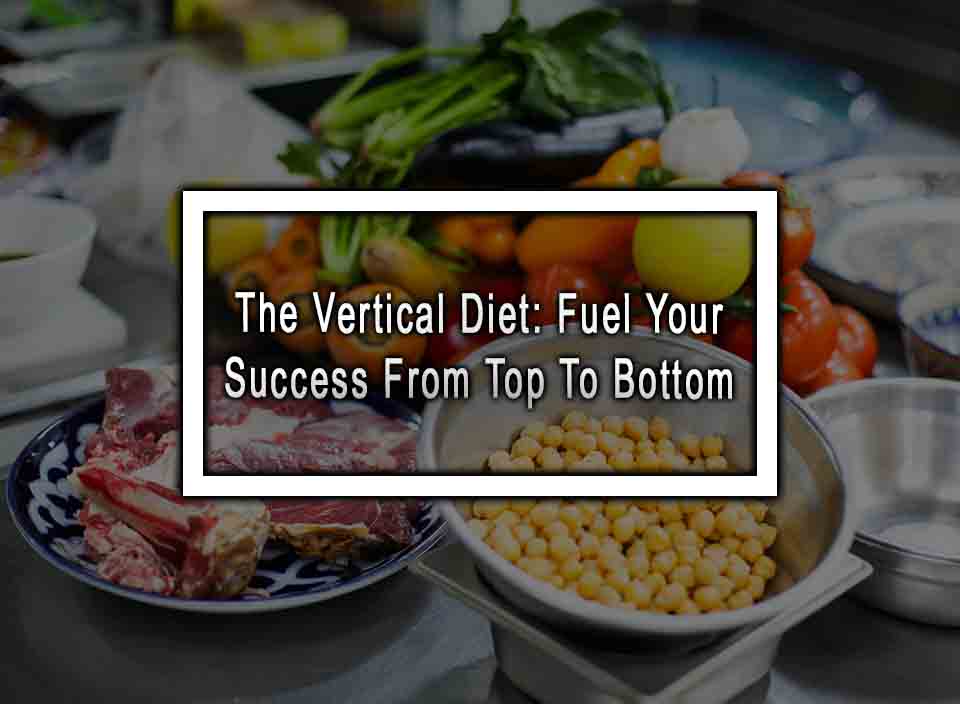Reaching New Heights: The Vertical Diet Takes Your Nutrition to the Next Level!
Unlock your full potential with the Vertical Diet! In this article, we delve into the benefits and intricacies of an increasingly popular dietary approach that has gained significant attention in the health and fitness world. Whether you are an athlete, a fitness enthusiast, or simply aiming to improve your overall well-being, the Vertical Diet offers a holistic and science-backed approach to optimize your nutrition and enhance performance.
Understanding the Basics of the Vertical Diet
The Vertical Diet is not just another fad diet; it is a well-formulated approach that focuses on consuming nutrient-dense foods to support digestion, energy levels, and overall health. Created by renowned nutritionist Stan Efferding, the Vertical Diet places importance on quality over quantity and emphasizes optimum digestion to maximize nutrient absorption.
Key Components of the Vertical Diet
1. Core Foods:
The Vertical Diet revolves around a variety of wholesome core foods. These include quality proteins such as beef, salmon, and eggs, accompanied by easily digestible carbohydrates like rice, potatoes, and fruit. Incorporating these nutrient-dense, easily digestible foods ensures an adequate supply of essential vitamins, minerals, and macronutrients.
2. Micronutrient and Digestive Support:
To further optimize digestion and nutrient absorption, the Vertical Diet recommends the inclusion of gut-friendly foods such as ginger and bone broth. This aids in maintaining a healthy gut microbiome and supports optimal digestion, reducing the risk of nutrient deficiencies and gastrointestinal issues.
3. Supplementation:
While the Vertical Diet primarily focuses on whole foods, supplementation can be utilized to bridge any gaps in nutritional requirements. Targeted supplementation, such as omega-3 fatty acids and vitamin D, may be recommended based on individual needs and the guidance of a qualified healthcare professional.
Unlocking the Vertical Diet Benefits
The Vertical Diet offers numerous benefits beyond mere weight management. Let’s take a closer look at how this dietary approach can positively impact various aspects of your life:
1. Optimal Performance:
By fueling your body with high-quality nutrients, the Vertical Diet aids in maximizing physical performance and recovery. Athletes and fitness enthusiasts who have adopted the Vertical Diet have reported increased strength, endurance, and overall performance.
2. Enhanced Digestion:
The emphasis on easily digestible foods, coupled with gut-friendly additions, helps promote a healthy digestive system, reducing discomfort and potential nutrient malabsorption. With improved digestion, individuals may experience increased energy levels and reduced gastrointestinal issues.
3. Sustainable Lifestyle:
Unlike restrictive diets that often lead to feelings of deprivation, the Vertical Diet is sustainable for the long term. It focuses on flexible eating and encourages the incorporation of varied and wholesome foods, allowing individuals to adhere to the diet while enjoying their favorite meals within the recommended guidelines.
Conclusion
Achieve extraordinary results with the Vertical Diet, a comprehensive nutrition approach that caters to both athletes and individuals seeking to optimize their health and well-being. By prioritizing nutrient-dense core foods, supporting digestion, and incorporating strategic supplementation, the Vertical Diet aims to unlock your physical and mental potential. Fuel your success from top to bottom with the Vertical Diet – your path to an optimized performance awaits!
Vertical Diet FAQs
Here are the most common questions about the vertical diet.
1. How does the Vertical Diet differ from other diets?
Unlike many other diets that restrict certain food groups or require strict calorie counting, the Vertical Diet emphasizes a balance of macronutrients and the consumption of nutrient-dense foods. It also considers individual needs and tailors the diet to the person’s activity level and goals.
2. Can the Vertical Diet be customized for specific dietary needs?
Yes, the Vertical Diet can be tailored to individual needs, including vegetarian or vegan options. It is important to consult with a registered dietitian or healthcare professional to ensure that nutrient requirements are being met while adhering to dietary restrictions.
3. Are there any potential drawbacks to the Vertical Diet?
While the Vertical Diet can provide a balanced and nutritious approach to eating, some people may find it restrictive or difficult to adhere to long-term. Additionally, it may not be suitable for individuals with certain medical conditions or severe dietary restrictions.
4. How can I get started with the Vertical Diet?
To get started with the Vertical Diet, it is recommended to consult with a registered dietitian or healthcare professional who can assess your individual needs and help create a personalized meal plan. Generally, the diet emphasizes lean proteins, nutrient-dense carbohydrates, healthy fats, and adequate hydration. Making gradual changes and incorporating foods from the recommended food list can help ease the transition.












